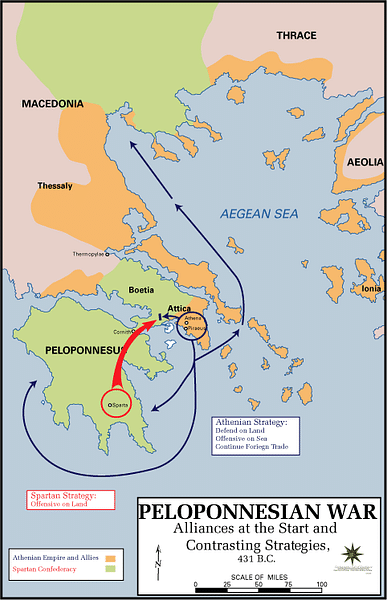
The Peloponnesian League (c. 550 BCE - c. 366 BCE) was a loose confederation of Greek city-states led by Sparta. The League was the oldest and longest-lasting political association in the ancient Greek world. For Sparta, the League gave it protection from uprisings within its own borders and eventually secured its dominance in the region and later, following victory in the Peloponnesian War in 404 BCE, the whole of Greece. Then, coming up against a rampant Thebes and their brilliant general Epaminondas, Sparta was defeated at the Battle of Leuctra in 371 BCE. Without its dominant leader the League dissolved shortly thereafter.
Membership & Responsibilities
The name of the League derives from the geographical location of its member states in the Peloponnese of southern Greece. The Greeks themselves referred to the association as 'the Lakedaimonians and their allies'. Unlike other confederacies such as the contemporary Delian League, the Peloponnesian League had no single binding agreement but was, rather, a collection of city-states (poleis) each having negotiated their own terms with dominant Sparta. In this sense, the League was no league at all as when not engaged in collective warfare city-states were even free to wage war against each other. Common features, though, of this loose association were the requirement of members to swear to hold common 'friends and enemies', promise reciprocal assistance, and follow the military ambition of their leader (hegemon), Sparta. Only in the case of a religious obligation (e.g. the necessity to observe a particular religious festival) could members refuse participation.
The League began in c. 550 BCE, according to Plutarch, so that Sparta might protect itself against both a possible uprising of Sparta's helots (semi-free agricultural labourers) and regional rival Argos, in the north of the Peloponnese. The first member was Tegea which, after resisting Spartan attack, was compelled to form an alliance. By 510 BCE the League encompassed all of the Peloponnese and, under the leadership of Cleomenes I, even spread further to include such cities as Megara and parts of Attica. In c. 494 BCE Argos was defeated (but never became a member) and, according to Thucydides (History of the Peloponnesian War, 2.9), over the next 50 years or so the League's membership spread further to include cities in Phocis and Boeotia.
Thucydides in his History of the Peloponnesian War describes the workings of the League. Members sent delegates to meetings where each city held one vote. This assembly was led by an ephor and decisions about such matters as military campaigns and new memberships were taken by majority. Interestingly, Sparta itself did not vote as their position had already been voted upon by the Spartan assembly. At the same time, there was a provision that Sparta would never have to act against her own interests. Unlike in the Delian League where Athens compelled members to pay a tribute under any circumstances, the members of the Peloponnesian League had only to contribute militarily when required. The exact number of troops demanded from each city was decided by Sparta. During the dangerous times of the Peloponnesian War (431 BCE - 404 BCE) against Athens and its allies, though, Sparta did go so far as to impose a military governor (harmost) on its allies.
Peloponnesian & Corinthian Wars
Besides having the largest and most formidable army, Sparta's domination of the Peloponnesian League was ensured by the fact that the League's military force was always led by a Spartan - either one of the two Spartan kings or a senior Spartan commander. Sparta also directly interfered in the domestic affairs of member states, often promoting rule by an oligarchy favourable to Spartan policy. Following victory in the Peloponnesian War against Athens in 404 BCE and the consequent addition of new Aegean allies, Sparta held an even tighter grip on member states and the harmosts were left in place.

In 404 BCE, tired of Elis' increasing sense of self-importance Sparta campaigned against its old ally and put the city-state in its place by 400 BCE. Continued Spartan ambitions in central and northern Greece, Asia Minor and Sicily once again dragged the city and the League into another protracted conflict, the Corinthian Wars. This pitted the League against Athens, Thebes, Corinth and Persia from 396 to 387 BCE. The result of the conflict was the 'King's Peace' where Sparta ceded its empire to Persian control but Sparta was left to dominate Greece.
Defeat to Thebes & Dissolution
Sparta's policy of interfering in the government of League members continued with their heavy-handed treatment of both Mantinea in 385 BCE, dividing up its villages, and with war against Phleious 381-379 BCE. From 382 BCE League tribute was required in money, not just arms and men as Sparta became ever more ambitious. However, Sparta over-reached itself in trying to crush long-time rival Thebes. The initial success of establishing a garrison at Thebes between 379 and 376 BCE only resulted in antagonising the Thebans. Sparta lost the Battle of Tegyra in 375 BCE to Thebes, now a rising power and about to enter its most glorious phase in history. The Spartans then lost the even more crucial Battle of Leuctra in 371 BCE against the brilliant Theban general Epaminondas. Thereafter, the League declined and, with the treaties formed between Corinth, Phleious and Thebes, the Peloponnesian League was, in effect, dissolved by c. 366 BCE.





